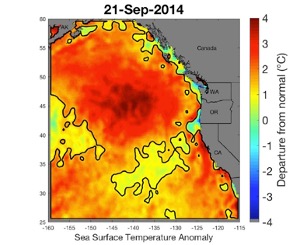Marine Heatwaves
Andrew Leising, Southwest Fisheries Science Center, NOAA, San Diego, CA, USA. Extracted from OOI Science Plan, 2021.
Marine heatwaves have been recognized as events that can have major impacts on the ocean, its ecosystems, and ocean-related human activities. Marine heatwaves have commonly come to be defined as regions of the ocean that have temperatures within the top 10% of all recorded temperatures for that location and time of year, and that persist for more than five days (Hobday, 2016). It was not really until the extremely large event that began in the Gulf of Alaska in fall of 2013 and lasted until mid 2015 – an event that became colloquially known as “The Blob” – that the potential importance and impact of non-El Niño, large-scale marine heatwaves was realized (Fig. to the right). Impacts of the “Blob” included changes in species distributions, reduced overall productivity, reduced numbers of economically important species, closure of fisheries, harmful algal blooms, and the occurrence of rare and novel species (i.e., tropical venomous sea snakes washing up on the coast of California; Cavole et al., 2016). In May 2019, a second large marine heatwave formed, which rivaled the “Blob” in terms of size and intensity, however it lasted only until February 2020, and did not have nearly the impacts of the 2013-2015 event. Nevertheless, research suggests heatwave frequency is expected to increase, and that the heatwaves themselves will possibly be of longer duration and intensity in the future, thus likely increasing their impacts on our marine ecosystems.
Marine heatwaves are caused by various forces, depending on the location and possibly season (Holbrook et al., 2019). In the Northeast Pacific (NEP), both the 2013-2015 and 2019 events are thought to have been initiated by changes in atmospheric patterns (Bond et al., 2015; Amaya et al., 2020). Essentially, changes in large scale atmospheric patterns change atmospheric pressure fields, which in turn alter winds over the surface of the ocean. When the wind decreases for a substantial enough time, this in turn leads to a lack of surface ocean mixing, changes in horizontal advection and, therefore, a reduction in the normal cooling that would occur; hence, the warming of the surface layers. Given time, this surface heating penetrates to deeper depths, further strengthening and perpetuating the heatwave. Anomalous atmospheric pressure patterns can also help to maintain a heatwave by steering storms away from the heatwave that would normally mix and cool surface waters. Lastly, given longer time periods, feedback loops between the warm water and atmosphere can develop, further affecting winds, heat flux, and even cloud cover, thus perpetuating the feature.
Ocean observing systems are a key tool in measuring and monitoring marine heatwaves. Remote observation of sea surface temperature (SST) from satellites has been an important tool for observing heatwaves, however, SST only provides data from the surface mixed layer, whereas heatwaves such as the “blob” had extensive sub- surface warming. Bond et al. ( 2015), McCabe et al. (2016), McKibben et al. (2017), and Barth et al. (2018) all used data from various OOI assets, particularly the Endurance Array, the RCA, and the Global Array at Ocean Station Papa, to monitor the approach of the “Blob” and its links to ecosystem impacts on the US west coast. What makes these OOI assets so valuable for the purposes of sampling and monitoring heatwaves is that: 1) they sample at high enough frequency to detect rapid changes that can be associated with the advection of heatwaves, 2) they sample subsurface and sub-mixed layer properties, 3) they are placed in an opportune location to detect features as they near the coast, and 4) they have been sampling over a long enough time period for the calculation of local climatologies – this is a key element for detecting anomalies such as marine heatwaves.
Moving forward, OOI assets such as the Endurance Array are poised to provide exactly the kind of data needed for marine heatwave detection and monitoring. However, the strengths of such a system also help identify possible gaps and challenges that could occur. Loss of sampling over time due to instrument failure, etc. would introduce gaps in data collection, thus additional redundancy of sensors and platforms would be preferred. Also, due to the extremely heterogenous shape of marine heatwaves (Fig. to the right), it would be preferable to add additional arrays to other locations along the US west coast; indeed the Endurance Array and RCA were uniquely positioned in 2014 to sample the “Blob” as it intersected the coast in that region, but might miss future events. Additional sub-surface sampling further offshore would increase our ability to monitor the coastward propagation of heatwaves, and further delve into the mechanisms which drive their persistence. In summary, the sub-surface sampling abilities of the OOI system provide a unique opportunity for future research into marine heatwaves.

